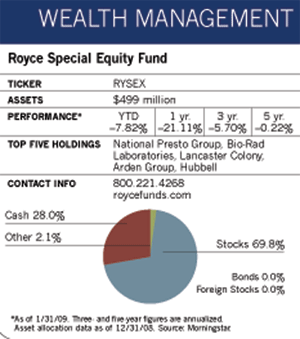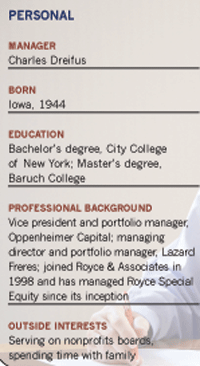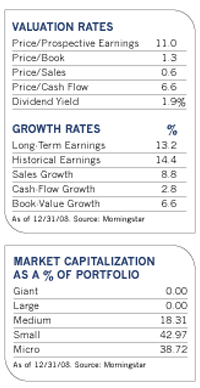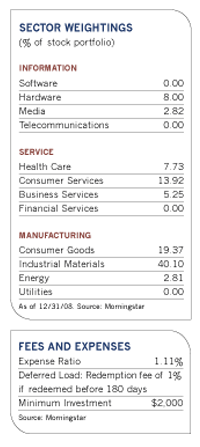Anyone old enough to remember the 1970s might recall long gas lines, rampant inflation and a brutal stock market. At the time, Charles Dreifus, then a young director of research at a New York brokerage firm, was struggling with so much bad economic news all the time that he remembers turning off his Quotron machine periodically to get a break from the devastation in the stock market.
In another part of the city not far from Dreifus' office, Charles Royce was battling investment demons of his own. In 1973, the year he took over the tiny Pennsylvania Mutual Fund from a colleague, he was weeding out the '60s-era "go-go" stocks that populated the fund and replacing them with what he considered a more resilient breed of small company shares. "I wanted to invest in small companies that paid attention to things like balance sheets and cash flow," he told Financial Advisor in a 2001 interview.
On the surface, Dreifus and Royce have little in common except perhaps for a first name. Dreifus, who was born on an Army base, was a first-generation American and the first in his family to graduate from college. He used his bar mitzvah money to buy stocks. Royce, meanwhile, has a penchant for bow ties that harks back to his days as a student at Brown University, a haven for blue bloods when he attended the school in the late 1950s.
Yet over the next 35 years, the two would share a friendship, as well as a similar investment style marked by attention to clean balance sheets, disdain for hot investment trends and a preference for simple-to-grasp business models. They are also stock market junkies, says Dreifus, who recalls that when he and Royce were at an investment meeting in Australia over 20 years ago they were the only attendees who preferred poring over financial newspapers to playing golf and snorkeling.
By the time Dreifus joined Royce's firm in 1998 to manage Royce Special Equity and handle institutional accounts, he had honed a style in sync with his employer's idea of what a good small company stock is: a piece of an unexciting yet dependable business that could chug along in all kinds of economic environments. To find them, the former accounting major looks at a company as if he were a potential acquirer as well as a stock investor. Price-earnings ratios are not always reliable, he says, since companies can easily fudge or inflate earnings. Instead, he looks at measures such as 12-month-trailing earnings before interest and taxes (EBIT) and return on invested capital, which he says better reflect a company's financial strengths or weaknesses and intrinsic value.
Stocks in the portfolio typically have ample cash on hand either to buy shares back or to distribute as dividends. He believes dividends will take on greater importance as stock market returns diminish, while buying back shares benefits existing shareholders because earnings are spread among fewer shares.
He also likes to see high levels of insider ownership, often by family members. "These companies are the family crown jewels. Their owners tend to pay a lot of attention to risk and have conservative management. And they often have transactional activity-such as a large, one-time cash dividend or the sale of the company-that ultimately benefits shareholders."
The screening process unearths companies with prosaic, simple businesses that the average fifth-grader can understand. National Presto Industries, the fund's largest holding at the end of November, produces appliances and household gadgets such as the PrestoBurger and FryBaby. Another top ten holding, Arden Group, is the parent company of Gelson's Markets, which operates 18 supermarkets in Southern California. Longtime holding Bio-Rad makes laser-scanning microscopes, diagnostic test kits and other products for the life science research and clinical diagnostics market. And Lancaster Colony Corporation, which makes specialty foods, glassware and candles, is one of just 21 U.S. companies to increase dividends each year since 1963.
If there is an Achilles' heel in Special Equity's portfolio, it is the dependence of its holdings on consumer spending. While weakening consumer demand can affect the large number of companies in the Royce portfolio whose sales are tied to industrial or consumer products, Dreifus believes they are strong enough to weather tough economic times. "Many small companies are having trouble finding financing, but the companies we're invested in have a large cash cushion," he says. "Among smaller companies, this is going to be a survivor-take-all environment, and the companies we own are going to be the survivors."
Bear Market Stamina
Pedestrian or not, Dreifus' picks helped the fund emerge from 2008 in better shape than the vast majority of its peers. It ended the year with a one-year total return of -19.6%, 17.4 percentage points better than the S&P 500 index and 12.6 percentage points over its average Morningstar small value fund category peer.
Limiting losses in a dismal year helped Dreifus snag Morningstar's Domestic-Stock Fund Manager of the Year award for 2008. In writing about the honor, Morningstar analyst Russ Kinnel said, "We have a lot of confidence in Dreifus' investing skills. His strategy shields against losses in bad markets even though it also means that Royce Special Equity lags in big market rallies."
That observation is borne out by the fund's bottom-decile finish among its small-cap value peers between 2003 and 2005, as well as its strong showing in 2007 and 2008. "This fund is not for people looking for big home runs, but for those who want a quiet and conservative way to enhance their capital," says its manager, who is all too familiar with performance-driven asset inflows and outflows. At the height of its popularity in 2004, it had nearly $1.5 billion in assets. At the beginning of 2009, it was about one-third that size.
Investors can credit at least part of the fund's relatively good performance last year to its lack of financial services and natural resource stocks, which were two of the worst-performing sectors at the time. At the end of September 30, the fund had 3% of its assets in the former group and 3.6% in the latter. The fund's avoidance of last year's market quagmires was a reflection more of the managers' long-standing investment preference than a prescient call, according to Dreifus, who says that he has always been skeptical of how analysts can arrive at precise earnings figures for financial services companies when there are so many variables involved, such as fluctuating interest rates, indeterminate loan quality and economic malaise. With fluctuating oil prices and unpredictable demand, energy companies are also quirky and difficult to peg.
The fund's unusually large cash stake of nearly 22% going into the fourth quarter also helped it sidestep some of the market's troubles, and at the beginning of 2009, cash remained at high levels. Usually, the fund has about 5% to 10% of its assets in cash to cover redemptions. But at the end of the third quarter, Dreifus did some tax loss harvesting and had to wait 31 days to get back into the stocks he sold because of the wash sale rule. By the time the waiting period had elapsed, he realized that the market was on shaky ground and kept the money on the sidelines. He continues to invest gradually on dips in prices of stocks he likes, calling the purchases "a cautious wade into the shallow end of the small-cap pool."
Not The 1970s
As they await better investment times, Dreifus and Royce try to lend some historical perspective to the current debacle by looking back on the 1970s, when they were carving their respective niches on Wall Street. "What I took away from that era was the notion that there are opportunities to be had, but you have to move into them carefully and be especially demanding about your investment requirements," he says. He points out that some of the worst corporate wreckage now has been concentrated in financial stocks, while the devastation in the 1973-1974 market was more widespread. He even sees some signs for hope. "My 40 years of investing experience says the market is acting better than it should given the economic news it's been presented with. I'm impressed by that."
At the same time, he expects more bad market news, further layoffs and store closings, and more company bankruptcies. "Perhaps November was a bottom for the stock market, but we still need greater thawing out in credit markets and, at a minimum, a slowing rate of economic deterioration for any genuine recovery to begin," he observes.
In a recent commentary on the firm's Web site, Royce remarked that both periods were marked by controversial wars, the departure of an unpopular president and uncertainty about the future of the U.S. economy. "While there is definitely a lot of pessimism in the media and elsewhere in the economy, I also think there's a sense that, however difficult our challenges are in the months and years ahead, we're capable as a nation of meeting them and ultimately succeeding. I don't recall much of that feeling when the economy was stalled in the '70s."



